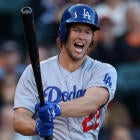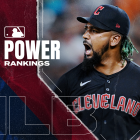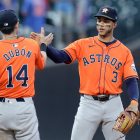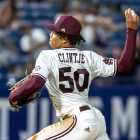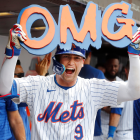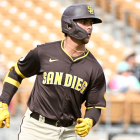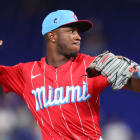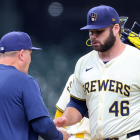The Major League Baseball Players Association is reportedly pushing to add a designated hitter to National League rosters as soon as this season, one of several eye-opening changes being batted around by the union, and MLB.
Per reports by Jeff Passan of ESPN and Ken Rosenthal of The Athletic, MLB on Jan. 14 tendered a proposal to the union for several rule changes, and the union responded with its own proposal on Friday. We'll get to some of the other exchanged ideas shortly. But first we need to tackle the most polarizing of the bunch, the universal DH.
It's fantastic! I don't usually use exclamation points in articles, but hell to the yes, it's about damn time!!!
OK, onto the calmer, more sober brand of analysis. Here are just a few reasons why the time is right to introduce the designated hitter into National League games:
- Pitchers can't hit. At all. As a group, they batted an atrocious .115/.144/.149. We can pick on the banjo-hitting Jeff Mathis types of the baseball world, but the worst-hitting position player in the league still annihilates that anemic batting line. Pitchers are worse at hitting now than they've ever been. Romantics like to rhapsodize about the genius-level strategy involved when it comes to second-inning bunts and fifth-inning pinch-hitter decisions. You know what's way more fun than those minor strategic moments? Effing dingers.
- "Max Scherzer/Zack Greinke/Madison Bumgarner are passable hitters, so you're wrong!" is not a viable counterargument. For every pitcher who doesn't embarrass himself at the plate there are dozens who make automatic outs, and humiliate themselves doing so. If a hitter like Matt Davidson decides to try his hand as a two-way player, that's definitely cool...but it's also his choice. If you forced hitters to pitch, the game would quickly become a joke. Though pitchers coming up to hit would happen far less frequently than our hypothetical all-hitters-must-pitch scenario, even one or two at-bats per game by a pitcher is still a farce that's ugly to watch.
- Pitchers don't train to be hitters. In high school, college, and the minors, the DH rule kicks in, turning hitting ability into a pointless skill. Hell, if a pitcher gets drafted by an American League team, then signs with a National League team as a free agent, it might be a decade and a half between bouts as someone who hits with any regularity.
- Because pitchers don't train to hit, they also don't train to run the bases. So while position players will have a lifetime to get used to stopping and starting and sprinting and sliding the way you would on the basepaths, pitchers (while still athletic) wouldn't be as prepared for those specific types of motions. This is how catastrophic injuries occur. Given that pitchers already have to dodge all the lat strains, shoulder impingements, and Tommy John surgeries under the sun, helping them avoid further injury risk is the right thing to do.
Though the DH rule officially took effect in 1973, its origins trace back to the 19th century, according to excellent MLB historian John Thorn. The intent then was the same as it is now: to replace the pitcher in the batting order with someone who'd do a better job of swinging the bat.
Still, it's particularly interesting that the union is pushing for a universal DH to arrive as soon as this season. At a time when even the brightest stars aren't generating anywhere near the level of interest you'd expect on the open market, the union could certainly stand to bag a few W's. The problem is that essentially replacing NL teams' worst relief pitcher or last guy off the bench with a DH spot probably won't generate the kind of additional revenue for the player pool that you'd hope for.
As Los Angeles Times writer Bill Shaikin noted, only two designated hitters stepped to the plate often enough to qualify for the batting title last season. Making the DH debate central to the union's pro-labor arguments thus risks wasting a bullet on a minor roster issue. Mega-sluggers who can't play the field like David Ortiz and Edgar Martinez are practically unicorns in today's game. Instead, teams typically use the DH spot to give position players quasi-rest days or to take pressure off minor, nagging injuries. From a pure labor perspective then, adding a mandatory universal DH merely grants NL teams the same ability to shuffle players across positions, but does not dramatically open up a new source of widespread, high-paying jobs.
That said, there are still real-life implications at stake here if the switch were to happen this season. First and foremost, the Mets would stand to benefit. The 7-Liners would seem overloaded with second basemen as things stand, following the offseason acquisitions of Robinson Cano and Jed Lowrie to go with the 2018 rookie-year emergence of Jeff McNeil (.329/.381/.471 in his 63-game MLB debut). Add a DH to the mix and you can slot the aging Cano there, give the sometimes fragile Lowrie a partial day off a couple times a week, and so on. Meanwhile projected part-time players such as Washington's Matt Adams and Colorado's Mark Reynolds could bag more at-bats by virtue of having an open lineup spot to occupy when they're not playing the field.
Throw all those factors into a blender and you get a move that's long overdue, but not revolutionary. MLB has earned a reputation as being glacially slow to change. But that description misrepresents the sport. From the constant changes that took place as the game gained its footing in the 19th century to shakeups that jolted baseball out of the Dead Ball Era to changes in mound height, the composition of balls, the shape of bats, the evolution of stadiums, and countless other upgrades, baseball has and will continue to evolve.
In fact, taking the DH to the National League looks like a relatively small (albeit still useful and welcome!) change when compared to some of the other proposals on the table. Going rapid-fire from the list quoted in Passan's article:
A three-batter minimum for pitchers
This one is meant to speed up the pace of games. Gone are the days when fans marveled at the brilliance of managerial tactics...if such a day ever truly existed. We watch games to see players perform, not watch paunchy 50-somethings trudge to the mound for the third time in 10 minutes (Gabe Kapler excepted, in every way). Yes, this could mean that the LOOGY (left-handed one-out guy) gets phased out of the game. But it would also increase the already sky-high demand for Josh Hader-type relievers who can vaporize every hitter they face, lefty or righty. All good.
A single trade deadline before the All-Star break
Works for me. The waiver-trade deadline was always opaque and confusing, and (with noted exceptions like the Justin Verlander blockbuster of 2017) tends to produce less action. Boil it down to one deadline and make it early enough to stimulate fan interest and force teams to be more decisive and less wishy-washy as they sit five games off the pace for the second wild-card spot.
A 20-second pitch clock
I suspect my initial resistance to the idea of a pitch clock stemmed from a reflexive desire to not mess with something as fundamental as pitcher-hitter tension. But crank up MLB classics and watch any game from the 70s and you'll find plenty of Tom Seaver-Willie Stargell battles that were every bit as tense and exciting as you'd hope, just without the endless staring and posturing and sign-running that often defines today's game. Pitchers might need a short adjustment period to get used to this, but I don't see a pitch clock affecting the game's quality of play -- just its pace of play. This works.
The expansion of rosters to 26 players, with a 12-pitcher maximum
Again from a labor-rights perspective, this isn't that big a deal. Given how reluctant teams are to sign even established quality players in free agency, it's a mortal lock that 26th-man jobs will come at league-minimum salaries. Still, 30 new jobs qualify as a good thing for the union. Moreover, for baseball nostalgists like me who yearn for Matt Stairses who can come off the bench and juice the game with late-inning thunder, ensuring another position player on every roster brings with it some intriguing possibilities.
Draft advantages for winning teams and penalties for losing teams
Yes, YES, YES!!! The notion of drafting in reverse order might've been intended to help foster parity and help along less successful, lower-revenue teams. But the actual effect of the current draft's status quo (and other baseball policies designed to level the playing field) is often to incentivize losing, and thus tanking. Obviously we need more information about what these draft advantages and penalties look like, because we don't want to suddenly start heaping more rewards on the Yankees of the world either. But at least in theory, there's potential here.
A study to lower the mound
Baseball's strikeout epidemic is far more closely connected to the quality and velocity of the pitches thrown by today's fire-breathers than it is to the uppercut efforts of today's launch angle-conscious sluggers. Lowering the mound could lead to fewer swings and misses and thus more balls in play. More balls in play leads to more in-game action. More action is a good thing.
A rule that would allow two-sport amateurs to sign major league contracts
Kyler Murray apparently got teams' attention.
Add it all up, and we have a list of ideas that wouldn't necessarily turn the game on its head, but might very well improve it. Some of these would also toss at least some minor concessions to a players' union that's growing increasingly disenchanted, thus perhaps engendering a little goodwill, and hopefully slightly lowering the possibility of a future labor stoppage.
Major League Baseball looks ready to change, and we are here for it.









